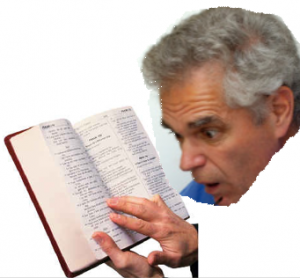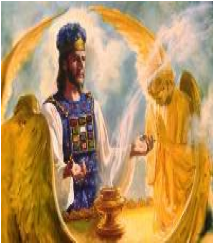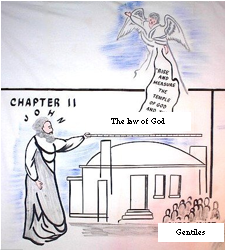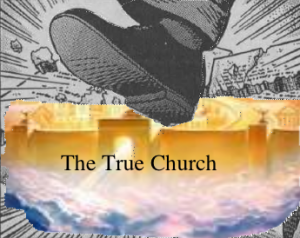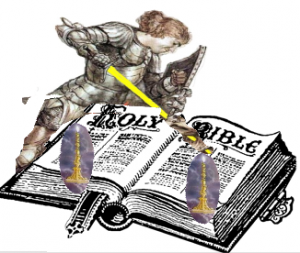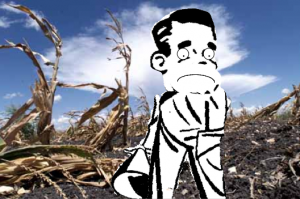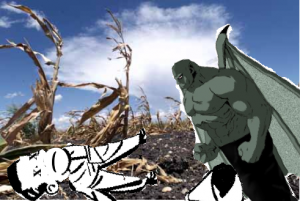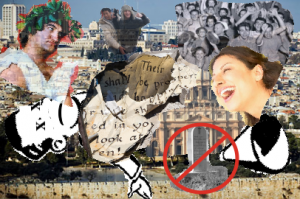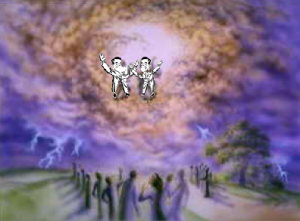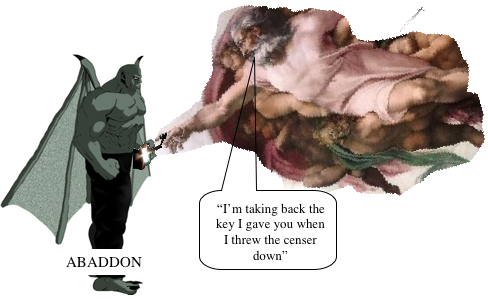The last verse of Chapter 10 left us in “the patient waiting time” [1] of the Laodicean period of church history, which could be considered “the present waiting time.”
The Commentary observes: “The line of thought in ch. 10 carries over into ch. 11.” [2] Therefore, the concluding “bitter book” episode of Revelation 10: 8-11 sent our pioneers back to the Bible. It opened to their “astonished eyes the cleansing of the sanctuary transpiring in heaven,” [3] not on earth. Those who continued to study found “that instead of coming to the earth at the termination of the 2300 days in 1844, Christ then entered the most holy place of the heavenly sanctuary, to perform the closing work of atonement, preparatory to his coming.” [4]
“The cleansing of the sanctuary therefore involves a work of investigative Judgment” [5] to see who is entitled to receive the benefits of Christ’s atonement; or to “see” who had on the “wedding garment” of Christ’s righteousness (Matthew 22:1-13).
Therefore, the “parenthesis between the sixth and seventh trumpets” [6] (which is in the midst of the sixth trumpet) that began in Revelation 10:1, took us back, retrospectively, in time, from the post probationary scenario of the sixth trumpet or second woe [7], to a time just after the “Lamb . . . came and took the book out of the right hand of him that sat upon the throne” (Revelation 5:6,7), which is also the time when Daniel saw “one like the Son of man” come “to the Ancient of days” at the end of the “two thousand and three hundred days” (Daniel 7:13; 8:14).
Therefore, it is reasonable to anticipate that the beginning point of Chapter 11 will be located somewhere after that great, heavenly event when the judgment of the dead began―October 22, 1844. However, based on quotes taken from the discourse on Revelation 11 in the book The Great Controversy, many have come to believe Revelation 11 deals exclusively with the events of the French Revolution [8] which transpired several years earlier, from 1789 to 1799. [9]
Unfortunately, few are aware of another important quote that provides a different perspective: “The Lord calls for His people to locate away from the cities, for in such an hour as ye think not, fire and brimstone will be rained from heaven upon these cities . . . Let all who would understand the meaning of these things read the eleventh chapter of Revelation. Read every verse, and learn the things that are yet to take place in the cities. Read also the scenes portrayed in the eighteenth chapter of the same book.” [10]
Therefore, based on this quote from White, we are unjustified in assigning the contents of this chapter exclusively to history prior to 1844, resting confident that it is of little concern to us in our time. So, lets attempt to “read every verse, and learn the things that are yet to take place . . .” If they are “yet to take place” they are matters that should be of deep concern to us.
Verse 1: And there was given me a reed like unto a rod: and the angel stood, saying, Rise, and measure the temple of God, and the altar, and them that worship therein.
Just a few moments ago, John took “the little book out of the [same] angel’s hand, and ate it up” (Revelation 10:10). Now he is given a “reed” and told to get up and begin measuring.
“The work is going on in the heavenly court. In vision on the Isle of Patmos John said: [this verse quoted] This solemn work is to be done on earth. Look and see how stands your measurement of character as compared with God’s standard of righteousness, his holy law.” [11] Therefore, we should consider ourselves to be members of this “temple of God,” and that we are being measured against God’s law.
Clearly, the “temple” is the church “on earth” and the “reed like . . . a rod” represents Gods law. By this time (96 A.D.) [12] the literal “temple” had been destroyed by the Romans (70 A.D). Therefore, that “reference is not to the literal temple in Jerusalem” because “the temple lay in ruins.” [13] Consequently, “The measurement of worshippers suggests a work of judgment” [14] that John was bidden to act out, just has he was bidden when asked to eat the “little book” ―an acted-out skit of God’s judgment of His church on earth. [15] This reflects back to where He critiques “them that worship” in the churches of Ephesus, Smyrna, Pergamos, Thyatira, Sardis, Philadelphia and Laodicea (Revelation 2 and 3). Lastly, while Jesus judged Laodicea to be nauseatingly “lukewarm” (Revelation 3:16), His message to John was given especially for this “last church” [16]. They are the ones who had just been given the responsibility of “prophesying again” (Revelation 10:11).
Because of the necessity of being measured, we can expect this church to have “tares among the wheat,” with the wheat representing “the children of the kingdom; but the tares are the children of the wicked one (Matthew 13:15-40). Consequently, this is “the church militant.” “Those who think that the church militant is the church triumphant make a great mistake. The church militant will gain great triumphs, but it will also have fierce conflicts with evil that it may be firmly established upon the platform of eternal truth.” [17]
“Let every one who is seeking to live a Christian life, remember that the church militant is not the church triumphant. Those who are carnally minded will be found in the church. They are to be pitied more than blamed. The church is not to be judged as sustaining these characters, though they are found within her borders.” [18]
Furthermore, “them that worship therein,” coupled with the act of measuring, suggests judgment is about to be applied to living worshippers, as “them that worship [present tense] therein.” In this act of judging, the false professors are weeded out from among the true. It will be accomplished when the judgment, that began October 22, 1844, with the cases of the dead, turns to the living (see on Revelation 6:9-11).
Verse 2: But the court which is without the temple leave out, and measure it not; for it is given unto the Gentiles: and the holy city shall they tread under foot forty and two months.
According to the Commentary, this “court has been regarded as representing this earth in contrast with ‘the temple of God’ in heaven (v. 1).” [19] Nevertheless, God’s people, even though “on earth” literally, dwell in heaven spiritually (see Revelation 12:12; 13:6). God’s people are only “strangers and pilgrims on the earth” (Hebrews 11:13), knowing that heaven is our home. In contrast, the wicked are those who “dwell upon the earth” without hope of ever dwelling in heaven (Revelation 3:10; 6:10; 11:10; 13:8, 12, 14; 17:8), living only for the present.
Both the Gentiles and the temple worshippers are actually on earth where “the holy city” has to be in order to be trodden “under foot.” To be trodden “under foot” is figurative of earthly persecution resulting in the purification that changes the church militant into the church triumphant, here called “the holy city.”
Purification is a process wholly unintended by the Gentiles who despise the church and wish to exterminate it. The false members, who were originally worshippers within “the temple,” are shaken out by the persecution into the “courtyard” where they join with the Gentiles and become some of the temple worshipper’s worst enemies. That certainly happened back in earlier days when from “the professed friends of the Reformation had risen its worst enemies.” [20]
The “forty and two months” or 1260 years of papal persecution, “representing the time in which the church of Christ was to suffer oppression from Rome,” [21] was preceded by the merging of apostate Christianity with paganism. According to Daniel, that was when the “vile person” came “in peaceably, and obtain[ed] the kingdom by flatteries. And with the arms of a flood shall they be overflown from before him, and shall be broken; yea, also the prince of the covenant” (Daniel 11:21, 22). But “in the great day of final atonement and Investigative Judgment, the only cases considered are those of the professed people of God. The judgment of the wicked is a distinct and separate work, and takes place at a later period.” [22] This “later period” is reference to the millennium, during which “judgment was given unto them [saints]” (Revelation 20:4), and the post millennium final destruction of the wicked.
Persecution is depicted in the book of Daniel by Gabriel who said: “they that understand among the people” will “fall by the sword, and by flame, by captivity, and by spoil . . . to try them, and to purge, and to make them white, even to the time of the end . . .” (Daniel 11:33, 35), a short while after the “vile person” and “them that forsake the holy covenant . . . shall place the abomination that maketh desolate” (Daniel 11:30, 31).
All through the ages, including the Reformation of the 16th century, the “believers in Christ, hated and persecuted by the world, are educated and disciplined in the school of Christ. On earth they walk in narrow paths; they are purified in the furnace of affliction. They follow Christ through sore conflicts; they endure self-denial and experience bitter disappointments; but thus they learn the guilt and woe of sin, and they look upon it with abhorrence. Being partakers of Christ’s sufferings, they can look beyond the gloom to the glory . . .” [23]
This experience is the “gold tried in the fire” (Revelation 3:18) offered the church during the Laodicean period. It will come into full swing when the “fifth seal” is opened and many of “the souls” who refuse to worship “the beast, neither his image, neither had received his mark” will be “beheaded” (Revelation 20:4) by the “Gentiles.” Those “souls” must be the “fellowservants . . . and their brethren, that should be killed” the same way the martyrs of history were treated because of “the word of God, and for the testimony which they held” (Revelation 6:9, 11). That is the “fifth seal” way-mark of history telling us that the judgment, which began with the dead, on October 22, 1844, will have turned to the living―the living here facing their final test of loyalty to God (being measured by the “reed” [Verse 1]) as they are confronted with the decision of whether or not to receive the “mark” of the “beast.”
Verse 3: And I will give power unto my two witnesses, and they shall prophesy a thousand two hundred and threescore days, clothed in sackcloth.
Although the word “power” is supplied in this verse, they actually do “have power . . .” according to Verse 6. Therefore, it is a proper term and should not, in any way, be dismissed. In this case, they are given “power” to “prophesy” for a specific period of time.
According to the Commentary, “A variety of interpretations . . . have been proposed” for the “two witnesses.” The most literal is that they represent “Elijah and Moses.” But the “fullest expression of the Holy Spirit to men is contained in the Scriptures of the OT and the NT . . .” [24] That agrees with White who interprets the “The two witnesses” as representative of “the Scriptures of the Old and the New Testament. Both are important testimonies to the origin and perpetuity of the law of God. Both are witnesses also to the plan of salvation. The types, sacrifices, and prophecies of the Old Testament point forward to a Saviour to come. The Gospels and Epistles of the New Testament tell of a Saviour who has come in the exact manner foretold by type and prophecy.” [25]
Verses 2 and 3 bring to our attention two time periods: the “forty and two months” and “a thousand two hundred and threescore days.” If we convert 42 “months” into “days” [26] we come up with the same number for both verses: 1260 days. From the historic perspective: “The periods here mentioned— ‘forty and two months,’ and ‘a thousand two hundred and threescore days’ —are the same, alike representing the time in which the church of Christ was to suffer oppression from Rome. The 1260 years of papal supremacy began in A. D. 538, and would therefore terminate in 1798.” [27]
But 1798 precedes 1844 by some 46 years, and 1844 was the year “the little book” became “bitter” to God’s people and was typified in John’s sweet/bitter experience (Revelation 10:10). This implies the necessity of deeper study before concluding this is all history and irrelevant to our time.
Going back to Revelation 10:11 John was told: “Thou must prophesy again” during the “patient waiting time” [28] since 1844. Then, Verses 1 and 2 of this chapter depict a progression of developments from the “patient waiting time” to a special time of testing like that endured by the church during the Dark Ages, represented by the “sackcloth” (Verse 3).
Although White did endorse the historic perspective, she also counsels us to “read the eleventh chapter of Revelation. Read every verse, and learn the things that are yet to take place in the cities. Read also the scenes portrayed in the eighteenth chapter of the same book.” [29] Therefore, the future application must certainly be considered.
That makes good sense, because the same twice mentioned “1260,” found in Verses 2 and 3, implies a double application. Consider that the “forty and two months” (representing the past―prophetic time) and “a thousand, two hundred and threescore days” (representing the future―literal time) say, in effect, the trampling “under foot” in the future will be similar to the past.
However, “the scene portrayed in the eighteenth chapter of” Revelation, referred to in the above statement, depicting the “power” given the “two witnesses,” is quite different from what took place during the Dark Ages when the Bible, as represented here by the “two witnesses,” was practically unobtainable.
The two angels (Revelation 18:1-4) can be seen as parallel to the “two witnesses” who bear the same messages aided by the “power” of the Holy Spirit. But, instead of the “thousand, two hundred and threescore days” representing 1260 years, according to the day-for-a-year method of calculating prophetic time, we need to remember that after 1844 there will be no more “prophetic time” as announced by the angel (Revelation 10:6) who says: “there should be time no longer.” [30]
Therefore, the 1260 years now amounts to three and a half years of literal time. [31] Furthermore, since there will be no more “definite time” after 1844, these three and a half years are “indefinite time,” that is, it is impossible to set a date for its beginning point.
There is another aspect of these two 1260-day time periods. It is first mentioned in Daniel 7:25, then Daniel 12:7. In Daniel 9:27, two additional 1260-day time periods are seen when the Messiah was crucified “in the midst of the [final] week” of the seventy. That divides that final “week” into two 3 1/2-year time periods or two 1260-day time periods. Therefore, a total of four 1260-day time periods are alluded to in the book of Daniel. Now, in Revelation 11:2, 3, we find, yet again, two additional 1260-day time periods bringing a total of six 1260-day time periods in Daniel and Revelation. But three more 1260’s are depicted in Revelation 12:6, 14 and 13:5, bringing a grand total of nine!
“Some prophecies God has repeated, thus showing that importance must be given to them. The Lord does not repeat things that are of no great consequence.” [32] Therefore, the nine 1260’s must, at least, be some of the “things . . . of . . . great consequence.” By now it should be evident that the “great consequence” of the “1260” is its great relevance to the future, as well as history. It forms what could be called a “connecting link” between the past and the future.
The figurative “sackcloth,” “a common sign of mourning and of penitence” in Old Testament times, [33] must represent, not only the hard times in which the message was delivered, but also the spirit in which the message is given. This rules out any arrogant or self-righteous attitude on the part of the proclaimers. They will have “to stand with a wonderful truth right before the whole world, and receive their opposition, and while receiving this opposition they [must] remember that they were sons and daughters of God, that they must have Christ formed within them the hope of glory. They were ever [to keep] in view the great and blessed hope that is before them.” [34]
Thus, again is brought to view “the scene portrayed in the eighteenth chapter” of Revelation where John “heard another voice from heaven, saying, Come out of [Babylon], my people, that ye be not partakers of her sins, and that ye receive not of her plagues” (Revelation 18:4). It follows, therefore, that this verse brings us to the sixth seal (Revelation 6:12 to 7:17), where the 144,000 and the “great multitude” are sealed with the seal of the living God in answer to the question of Revelation 6:17, “who shall be able to stand?”
Verse 4 These are the two olive trees, and the two candlesticks standing before the God of the earth.
While “seven candlesticks” (Revelation 1:12, 13, 20) are depicted in the first chapter, here we see only two.
Also, this is the only time John uses the figure of “two olive trees.” The only parallel is in the prophecies of Zechariah where he “looked, and behold a candlestick all of gold, with a bowl upon the top of it, and his seven lamps thereon, and seven pipes to the seven lamps, which are upon the top thereof: And two olive trees by it, one upon the right side of the bowl, and the other upon the left side thereof.” Even though the New Testament did not exist in Zechariah’s time, he was told “This is the word of the LORD unto Zerubbabel, saying, Not by might, nor by power, but by my spirit, saith the LORD of hosts” and adding “These are the two anointed ones, that stand by the Lord of the whole earth.” (Zechariah 4:2, 3, 6, 14, underlining supplied)
Since the “two witnesses” represent the Old and New Testaments, the “two olive” trees, which furnish fuel for the “two candlesticks,” must be figurative representations of the source of the Holy Spirit which enabled “Zerubbabel” to carry out his assigned mission. The olive oil from the two “trees” was represented in the ancient, wilderness sanctuary as “pure olive oil beaten for light, to cause the lamp to burn always” (Exodus 27:20). It typifies the “power” given the “two witnesses” enabling them to “prophesy” for “a thousand two hundred and threescore days” in spite of being “clothed in sackcloth.”
Even though John says nothing more about the “two olive trees,” he was told “the seven candlesticks which thou sawest are the seven churches.” (Revelation 1:20). Applying that figure to the “two candlesticks,” requires us to select only two of the seven churches of Chapters 2 and 3. Note that, of all seven churches, only two receive no rebuke from the Lord. Smyrna, in spite of its material “poverty,” was told: “thou art rich” (Revelation 2:9) and Philadelphia was commended because: “thou hast a little strength, and hast kept my word . . . hast not denied my name” (Revelation 3:8).
But “the synagogue of Satan,” afflicted both Smyrna and Philadelphia (Revelation 2:9; 3:9). Smyrna had to endure their “blasphemy,” while Philadelphia was promised Satan’s “synagogue” would, at last, “come and worship before [their] feet,” confessing that Jesus “loved” them (Revelation 3:9). [35]
Although we cannot extract the historic churches from their past and recreate them to bear the loud cry, it seems clear that their experience will be relived by God’s people at the very end of the Laodicean period of church history. Then the figurative “synagogue of Satan” will blaspheme “the holy city,” boasting that “’angels from heaven have spoken to us (referring to those whom Satan personated that had died, and they claimed had gone to heaven). You will hear the testimony of the heavenly messengers.’ They sneered, they mocked, they derided and abused the sorrowing ones.” But the abuse will not quench their faith. “One said, ‘Look up! Look up!’ Every eye was lifted, and the heavens seemed to part as a scroll when it is rolled together, and, as Stephen looked into the heaven, we looked. The mockers were taunting and reviling us and boasting of what they intended to do to us if we continued obstinate in holding fast our faith.” [36] God will vindicate them when He causes the “synagogue of Satan . . . to come and worship before [their] feet.”
Verse 5: And if any man will hurt them, fire proceedeth out of their mouth, and devoureth their enemies: and if any man will hurt them, he must in this manner be killed.
This passage is less difficult to understand when we remember “them” and “their” refer to the “two witnesses” ―the Old and New Testaments. Their mouths are figurative of the words contained therein.
How can the written words of the Bible be “hurt?” Obviously, by false witnessing, false testimony, false prophesying, ridiculing or contradicting them. White says it better. After quoting Verse 5, she writes: “Men cannot with impunity trample upon the Word of God. The meaning of this fearful denunciation is set forth in the closing chapter of the Revelation: ‘I testify unto every man that heareth the words of the prophecy of this book, If any man shall add unto these things, God shall add unto him the plagues that are written in this book: And if any man shall take away from the words of the book of this prophecy, God shall take away his part out of the book of life, and out of the holy city, and from the things which are written in this book. (Rev. 22:18, 19.)” [37]
This “fire . . . out of their mouth” which devours “their enemies” does not mean God’s final day messengers will be going around with flame throwers; rather they will be giving the “straight testimony” of God’s word which, hopefully, brings conviction and repentance to the heart of the hearer. Therefore, it is tampering with, “hurting” or attempting to change the message, that will ultimately bring the devouring “fire” causing “any [presumptuous] man” to be “killed” with the “second death” (Revelation 2:11; 20:6, 14; 21:8). God Himself, not His servants, will be the responsible agent.
Verse 6: These have power to shut heaven, that it rain not in the days of their prophecy: and have power over waters to turn them to blood, and to smite the earth with all plagues, as often as they will.
The “days [38] of their prophecy” are depicted in Verse 3 as the time when “my two witnesses . . . shall prophesy a thousand two hundred and threescore days . . .”
Although the power to “shut heaven” and turn “waters to blood” is reminiscent of the stories of Elijah (1 Kings 17:1-7 in 910 B.C.) and Moses (Exodus 7:17-21 in 1491 B.C.), this verse depicts these miracles, together with “all [other] plagues,” occurring simultaneously! Furthermore, nothing like this took place during the 1260 years of the Dark Ages, and certainly not on the global scale depicted here. So, again, we are reminded to “read the eleventh chapter of Revelation, Read every verse, and learn the things that are yet to take place in the cities. Read also the scenes portrayed in the eighteenth chapter of the same book.” [39]
Therefore, these must be some of the “signs and wonders” that “follow the believers” as these “servants of God, with their faces lighted up and shining with holy consecration . . . hasten from place to place to proclaim the message from Heaven” during the time of the “latter rain.” These miracles will occur in order to bolster their testimony and to compel “the inhabitants of the earth . . . to take their stand” [40] either for or against the truth.
Verse 7: And when they shall have finished their testimony, the beast that ascendeth out of the bottomless pit shall make war against them, and shall overcome them, and kill them.
White declares: “This prophecy has received a most exact and striking fulfillment in the history of France. During the Revolution of 1793 . . .” [41] But, the same author also wrote: “read the eleventh chapter of Revelation, Read every verse, and learn the things that are yet to take place in the cities.” [42] The first statement puts this verse back in the 18th century, while the last places this (as well as all the other verses of this chapter) in the future. Thus, we should conclude, the French Revolution was a fulfillment of this verse in a prototypical sense. The ultimate, and final fulfillment lies in the future when the “testimony” of the Bible is “finished” for all “they that dwell upon the earth” (Verse 10), not only the country of France.
In that case, the paradigm of Chapter 11 has shifted from the probationary parenthetical scenario (Revelation 10:1-11:6) to post probationary time and the continuation of the sixth trumpet scenario.
Here we see the “beast that ascendeth [43] out of the bottomless pit,” presented in the progressive sense, suggesting that he had already been busy manifesting himself. He was introduced as the “star” who fell “from heaven” and received “the key of the bottomless pit” (Revelation 9:1), identified as “the angel of the bottomless pit” whose “name in the Hebrew tongue is Abaddon, but in the Greek tongue hath his name Apollyon” (Revelation 9:11); and He is also the same “beast” that “shall ascend out of the bottomless pit, and go into perdition” (Revelation 17:8). There is no other person who fits these descriptive terms better than Satan who commanded the “locusts” (Revelation 9:1-11) and masqueraded as “Wormwood” (Revelation 8:10, 11). Here, his “war against” the testimony of the “two witnesses” appears to be successful because they will be “overcome” and even killed!
Since the “two witnesses” represent the written word of God, or more specifically, the Bible, how can it be “killed,” or as the prophet Amos declared (see Amos 8:11-13), how can there be “a famine . . . of hearing the words of the Lord” when Bibles are available to anyone who cares to read them? Other than the withdrawal of the Holy Spirit, which is essential in the acceptance of God’s word, the answer, in this context, seems to be that it is the death of the messages of the “two witnesses” who strove to alert the world of what is coming.
At this point, and to the immense satisfaction of “them that dwell upon the earth,” the “two witnesses” messages have been “proven” false, or at least assumed so, to earth dwellers’ great satisfaction. Although Satan’s “war against” the Bible has been ongoing for centuries, he has maintained “a studied effort . . . to conceal from men that which reveals his deceptions. For this reason, Christ the Revelator, foreseeing the warfare that would be waged against the study of the Revelation, pronounced a blessing upon all who should read, hear, and observe the words of the prophecy.” [44] In this context, this “blessing” will be realized to its fullest extent. Those who understand this prophecy, will not at all be disheartened by Satan’s apparent victory over the testimony of the “two witnesses.” They will have already seen the “five months” (Revelation 9:5, 10) period of torment fulfilled and the vicious retaliation of those who had “not the seal of God in their foreheads” (Revelation 9:4) who had just killed “a third part of men” (Revelation 9:15, 18).
In contrast, those who have been reluctant “to investigate its teachings” will face the same kind of discouragement faced by Christ’s disciples who were hiding behind closed doors “assembled for fear of the Jews” (John 20:19; but here, the fear of the earth dwellers) instead of rejoicing that Jesus had risen from the grave, as they could have expected had they paid attention to what Jesus had been telling them.
Verse 8: And their dead bodies shall lie in the street of the great city, which spiritually is called Sodom and Egypt, where also our Lord was crucified.
These are not the “dead bodies” of those who were killed in the battle of the sixth trumpet, but the “dead bodies of the “two witnesses,” representing the “Scriptures of the Old and the New Testament,” lying humiliated “in the street of the great city.” [45] Since the spiritual nature of “the great city” is likened to the lasciviousness and hedonism of “Sodom,” and the atheistic paganism of “Egypt,” it cannot be the “holy city” (Verse 2), but “Babylon . . . that great city [which] made all nations drink of the wine of the wrath of her fornication” (Revelation 14:8). But the final specification, “where also our Lord was crucified,” gives us pause. The historic application explains it as figurative of “Christ in the person of his disciples” [46] who were persecuted during the French Revolution. [47] However, it is abundantly clear these are some of “the things that are yet to take place in the cities.” [48]
The city “where also our Lord was crucified,” namely Jerusalem in Palestine [49] is where the “vile person . . . shall plant the tabernacles of his palace between the seas in the glorious holy mountain” (Daniel 11:21, 45). Both passages depict the literal city of Jerusalem, the future headquarters of the “vile person” and the “great city” of mystical “Babylon.”
Consequently, at this point in the scenario of the sixth trumpet, the headquarters of the “vile person” in the Vatican will have been transferred from Rome to Palestine. It likely will take place soon after the catastrophe when the second trumpet (Revelation 8:8, 9) has sounded, after which “Wormwood,” who appeared when the “third angel sounded” (Revelation 8:10, 11), must have engineered that change. (see Daniel 11:45)
[More details on this subject in Chapters 17 and 18.]
Verses 9, 10: And they of the people and kindreds and tongues and nations shall see their dead bodies three days and an half, and shall not suffer their dead bodies to be put in graves. And they that dwell upon the earth shall rejoice over them, and make merry, and shall send gifts one to another; because these two prophets tormented them that dwelt on the earth.
These verses stipulate that all “people, and kindreds and tongues and nations . . . that dwell upon the earth” will cast contempt upon God’s word, suggesting that the whole world will be engaged in celebrating an extraordinary embarrassment of God’s word.
In contrast, during the French Revolution in 1793: “The world stood aghast at the enormity of guilt which had resulted from a rejection of the Sacred Oracles, and men recognized the necessity of faith in God and His word as the foundation of virtue and morality.” [50] Consequently, only one nation, such as France, could not fulfill this specification, which clearly involves the whole world, thus placing this scene in the future [51] as confirmed by White’s warning to “learn the things that are yet to take place.” [52] France’s revolutionary history serves well to illustrate what this dreadful scenario will be like universally.
The world will not stand aghast at the enormity of its guilt,” rather it will revel in what it thinks is its vindication and “rejoice” and “make merry.” But its joy will be short lived―a literal “three days and an half.” [53]
The torment caused by the “two witnesses,” felt by “them that dwell on the earth,” could not be the same as the excruciating “torment of a scorpion” experienced by “those men which [had] not the seal of God in their foreheads” (Revelation 9:4, 5). In contrast, this torment is not physical, rather, it is spiritual. Because the warning messages of the “two witnesses” were so strong and forceful, it was impossible for the earth dwellers to ignore what they were saying. In spite of doing all they could to silence the reproving voice of God’s two witnesses, their efforts proved futile. The words of the two witnesses, warning them what would happen after the close of probation (Verses 3-6), continued to haunt them. Nothing could silence them. They found themselves powerless to forget what they heard.

But now, with the two witnesses dead, they [the world] thought it was the beginning of “the temporal millennium that they had been expecting so long. The whole world was converted and in harmony with the Sunday law, and this little feeble people [who had given the message of the ‘two witnesses’] stood out in defiance of the laws of the land and the law of God, and claimed to be the only ones right on the earth.” [54] Their persecutors boasted that: “’angels from heaven have spoken to us (referring to those whom Satan personated that had died, and they claimed had gone to heaven). You will hear the testimony of the heavenly messengers.’ They sneered, they mocked, they derided and abused the sorrowing ones” [55] who understood, preached and lived by the messages of the two witnesses.
Verse 11: And after three days and an half the Spirit of life from God entered into them, and they stood upon their feet; and great fear fell upon them which saw them.
What is “the Spirit of life from God?” Earlier, John wrote down the words of Jesus who said: “the words that I speak unto you, they are spirit, and they are life” (John 6:36).
In 1793 it was a series of “decrees which abolished the Christian religion and set aside the Bible.” [56] In the future it will be the overwhelming victory of the followers of Wormwood over Abaddon which will be assumed to prove the message of the two witnesses false. Now, after “the Spirit of life from God entered into” the two witnesses, enabling them to regain their footing, they regained their power to convict, that conviction causing “great fear,” or terror in those “which saw [64] them,” suggesting not all are terrorized.
Those who are not terrorized must be the two thirds of the men which were not killed by the “red horse” people led by Wormwood―killing by fire smoke and brimstone from the mouths of the strange horses (Revelation 9:17, 18). These survivors are the “pale horse” people under the leadership of Abaddon.
Now, they (Abaddon followers), instead of the victors, feel vindicated! Even though the followers of Wormwood thought the “two witnesses” were “dead” after they defeated the heathen Abaddon followers, it was only illusionary. With awful incredulity, they suddenly realize they had been duped by the greatest fraud that was ever perpetrated upon the human race―Abaddon and Wormwood are both Satan!
Verse 12: And they heard a great voice from heaven saying unto them, Come up hither. And they ascended up to heaven in a cloud; and their enemies beheld them.
After quoting this verse from the historic perspective, White comments: “Since France made war upon God’s two witnesses, they have been honored as never before. In 1804 the British and Foreign Bible Society was organized. This was followed by similar organizations, with numerous branches, upon the continent of Europe. In 1816, the American Bible Society was founded. When the British Society was formed, the Bible had been printed and circulated in fifty tongues. It has since been translated into more than two hundred languages and dialects.
“For the fifty years preceding 1792, little attention was given to the work of foreign missions. No new societies were formed, and there were but few churches that made any effort for the spread of Christianity in heathen lands. But toward the close of the eighteenth century a great change took place. Men became dissatisfied with the results of rationalism, and realized the necessity of divine revelation and experimental religion. From this time the work of foreign missions attained an unprecedented growth.” [65] Therefore, what was formerly scorned is now honored, representing a dramatic sea change in public opinion.
In the future application, we again see a great change in public opinion regarding the message of the “two witnesses” represented by their figurative resurrection. Consequently, as unlikely as it may seem, an incredible respect for the testimony of the two witnesses will evidently take place during post probationary time. This could well be the time when “the synagogue of Satan, which say they are Jews, and are not, but do lie . . . come and worship before thy feet . . .” (Revelation 3:9)
Perhaps this is the time Amos refers to: “Behold, the days come, saith the Lord God, that I will send a famine in the land, not a famine of bread, nor a thirst for water, but of hearing the words of the LORD: And they shall wander from sea to sea, and from the north even to the east, they shall run to and fro to seek the word of the LORD, and shall not find it” (Amos 8:11,12). They cannot “find it” because, spiritually speaking, the two witnesses have “ascended up to heaven in a cloud” and are now out of reach.
Verse 13: And the same hour was there a great earthquake, and the tenth part of the city fell, and in the earthquake were slain of men seven thousand: and the remnant were affrighted, and gave glory to the God of heaven.
This verse, as brief as it is, describes the event responsible for the great change in public opinion regarding the message of the “two witnesses.” Now, a dark cloud of doubt shadows their joyous expectations for a coming thousand years of peace and prosperity.
Keep in mind this is the concluding episode of the sixth, post probationary trumpet scenario during which Satan is allowed full control of the wicked.
Therefore, the “great voice from heaven” enabling the “two witnesses” to ascend “up to heaven” does not cause this “great earthquake,” rather it is symbolic of a heavenly ratification of the renewed, worldly respect for their messages.
Consequently, the perpetrator of this “earthquake” must be Satan, the destroyer. Note, even though it is described as “a great earthquake,” only “the tenth part of the city fell” suggesting it is very localized. Therefore, “this is not the final earthquake, for only a fraction of the city falls at this time. . . Some apply the expression . . . to the entire nation of France . . . Others identify the city as papal Rome . . .” [66] Verse 8 specifies it as the place “where . . . our Lord was crucified,” namely, Jerusalem in Palestine.
Although the world as a whole was engaged in celebrating the death of the two witnesses, a large celebration must have been taking place in Jerusalem, Wormwood’s new headquarters, at the time of this “earthquake.” But, as localized as it was, “seven thousand” men “were slain,” which mandates a literal application of a very real “earthquake.” The “remnant” who survived the “earthquake” are seized with the “great fear [that] fell upon them which saw” (Verse 11) or now believed the “two witnesses.” Needless to say, they now regret the humiliation they heaped upon the “two witnesses.” The “merry” making and sending of “gifts one to another” ceases the moment this “great earthquake” shakes them back to their senses.
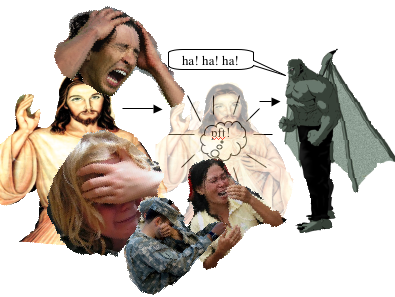
The “same hour,” must be the eighty-fifth “hour” after the “three days and an half” (Verses 9, 11) had expired. Apparently, Wormwood now throws aside his disguise as Christ, and reveals that he is actually Abaddon, or Apollyon, the “destroyer” (Revelation 9:11), the “angel of the bottomless pit,” who had duped many into believing he was the Christ come to save the world from the grip of the pale horse people led by Abaddon. This scenario shows the essence of the name “Wormwood” which is the name of “a notoriously bitter herb, Artemisia absinthium” [67] illustrative of the bitter disappointment now suffered by Wormwood’s followers.
They are like the antediluvians who pounded on the door of the ark for admittance as the waters of the flood engulfed them. In that sense, they gave “glory to the God of heaven” recognizing the truth of Noah’s preaching. Those who are now betrayed realize, to their horror, that Wormwood was the same person as Abaddon, the “destroyer!” The 144,000, like Noah, had warned them of this eventuality which makes their disappointment even more painful.
Verse 14: The second woe is past; and, behold, the third woe cometh quickly.
After the fourth angel sounded his trumpet, another “angel” flew “through the midst of heaven, saying with a loud voice Woe, woe, woe, to the inhabiters of the earth by reason of the other voices of the trumpet of the three angels, which are yet to sound!” (Revelation 8:13). Therefore, the first “woe” was the fifth trumpet (Revelation 9:1-11), and the second “woe,” began when “the sixth angel sounded” his trumpet (Revelation 9:12, 13). Consequently, the first part of the “second woe” is covered in Revelation 9:13-21 and completed in Revelation 11:7-13. [68] [69]
White warns: “Solemn events before us are yet to transpire. Trumpet after trumpet is to be sounded, vial after vial poured out one after another upon the inhabitants of the earth. Scenes of stupendous interest are right upon us.” [70] With this Divine mandate to view these things from a future perspective [71] we must, therefore, regard verses 7-13 as post probationary, beginning at the time when the “two witnesses” “shall have finished their testimony.” Note the word “quickly,” [72] meaning: “without delay.” That makes clear there is no interruption, or no lapse of time between the end of the “second woe” and the beginning of the “third.” [73]
Verse 15: And the seventh angel sounded; and there were great voices in heaven, saying, The kingdoms of this world are become the kingdoms of our Lord, and of his Christ; and he shall reign for ever and ever.
As the Commentary suggests, “The seventh angel . . . marks the beginning of the third woe” but adds that it is “the end of the parenthesis between the sixth and seventh trumpets.” [74] While this verse clearly indicates a transition from the sixth to the seventh trumpets, Verse 14 clearly indicates the lack of an intervening “parentheses” because “the second woe is past; and, behold the third woe cometh quickly” or without delay.
The difficulty is easily resolved if we are willing to allow Verse 7, when the two witnesses “shall have finished their testimony,” to be “the end of the parenthesis” that began in Chapter 10:1 and ended in Chapter 11:6. But we must also concede that the “parenthesis” is not between the “sixth and seventh” trumpets, but toward the end of the sixth trumpet! Another important point to recognize is that “the seventh angel” is the same angel referred to in Revelation 10:7: “in the days of the voice of the seventh angel, when he shall begin to sound, the mystery of God should be finished.” Therefore, we should expect to see the “mystery of God” ended in the scenario of the “seventh angel” or “third woe.”
According to our understanding of Verses 9-13, some of “the people and kindreds and tongues and nations” of the world believe that Wormwood is God, while others hold to Abaddon. The “great earthquake” of Verse 13 proved Wormwood, the false Christ, to be fraudulent. Now, all are converted to Abaddon, or Apollyon, the destroyer. All this happened after the “four angels standing on the four corners of the earth” had released “the four winds,” representing “the terrible power of Satan,” and Jesus had taken “the censer, and filled it with fire of the altar, and cast it into the earth” (Revelation 7:1-3 and 8:5) signaling, not only the close of probation, but Satan’s release to exercise unhampered control of the wicked. [75] The six successive trumpet episodes characterize the nature of his demonic rule, during which all “that dwell upon the earth” [76] regard Satan (either in the form of Wormwood or Abaddon) to be “God.” The “mystery” still exists of who is the real God.
Note that these “voices” are from “heaven” in contrast to the previous six trumpet bearing angels which give warnings of what is to take place on earth. Saying that “the kingdoms of this world are [now] become the kingdoms of our Lord” suggests they were not previously, the Lord’s “kingdoms.” That concept coincides with Revelation 9:1 where the “star” that fell “from heaven unto the earth” was “given the key of the bottomless pit,” because he is the “angel” or “the beast that ascendeth out of the bottomless pit,” and was given control over all the wicked during the first six trumpet scenarios, inclusive of the first and second woes. [77]
Therefore, the seventh trumpet depicts God taking back the “key” He had given to Satan after the four angels (Revelation 7:1-3) had released their hold on the “four winds of the earth,” representing the “terrible power of Satan.” [78] Jesus’ action of throwing down the fire filled “censer” (Revelation 8:5) was the signal to the six trumpet bearing angels to begin sounding their trumpets―after God’s servants had been sealed in their foreheads (Revelation 7:4-8). Now, instead of Wormwood or Abaddon maintaining rule for the next thousand years, God takes control and will maintain it “for ever and ever!”
Verse 16: And the four and twenty elders, which sat before God on their seats, fell upon their faces, and worshipped God,
These are the men who took their seats “about the throne” at the beginning of the Investigative Judgment (Revelation 4 & 5). On previous occasions, they had fallen “down before him that sat on the throne” (Revelation 4:10) and had fallen “down before the Lamb” (Revelation 5:8) when He “had taken the book,” and when all the other angels joined in (Revelation 5:14). They also “fell before the throne on their faces, and worshipped God” when they saw and heard the “great multitude” waving palm branches and singing “Salvation to our God” (Revelation 7:10, 11). Now, after seeing Satan exercising his unopposed power over the wicked, these men are extremely grateful to see God stepping in to bring to end Satan’s reign and finish “the mystery of God” once and for all.
Verse 17: Saying, We give thee thanks, O Lord God Almighty, which art, and wast, and art to come; because thou hast taken to thee thy great power, and hast reigned.
The Commentary suggests a better rendition of the last phrase of this verse: “’has taken . . . didst reign,’ that is, hast taken and didst begin to reign. The triumphant reign begins with God’s asserting His omnipotence.” It goes on to say: “God has ever been all powerful, and the reign of sin has been only by His sufferance, that the true nature of evil might be revealed to created beings. When that purpose has been accomplished, then He takes His ‘great power’ and once more reigns supreme.” [79] Therefore, this verse makes clear what has already been said (Verses 15, 16) which is that God allows Satan to demonstrate his evil reign during the first six trumpet scenarios. During the seventh trumpet episode, He Himself retakes control and demonstrates who God really is by completely overthrowing Abaddon, the destroyer.
Verse 18: And the nations were angry, and thy wrath is come, and the time of the dead, that they should be judged, and that thou shouldest give reward unto thy servants the prophets, and to the saints, and them that fear thy name, small and great; and shouldest destroy them which destroy the earth.
In Verses 9 and 10, the “nations . . . and they that dwell upon the earth” were celebrating the death of the two witnesses who “tormented them.” Their joy was short lived when suddenly, after “three days and a half,” they were seized with “great fear” and were “affrighted” feeling compelled to give “glory to the God of heaven” (Verses 11-13). Such a radical change in outlook by the earth dwellers must have been caused by the “great earthquake” (Verse 13) that destroyed “the tenth part of the city” of Jerusalem (“where . . . our Lord was crucified” -Verse 8) including “seven thousand” “men” who, evidently, were devoted followers of Wormwood, the false Christ.
Although this is a speculative attempt to understand this scenario, it seems they must have gathered themselves together to commemorate Wormwood’s new headquarters in Jerusalem and were expecting him, having led them to victory during the sixth trumpet scenario (Revelation 9:13-21), to assign them to honored positions in his coming, thousand-year Utopian kingdom. A similar attitude was manifested by Jesus’ disciples, including Judas, who were looking forward expectantly to Jesus’ establishment of an earthly kingdom that would free them from Roman oppression. But, like the disciples who were crushed with bitter disappointment when they witnessed Christ’s crucifixion, the earth dwellers in this scenario (the “synagogue of Satan” -Revelation 2:9, 3:9) were bitterly disappointed because they evidently attributed the responsibility of the “great earthquake” (Verse 13) to the person they thought was Christ. Now they realize he is not Christ at all, because he has just manifested the behavior of Abaddon/Apollyon, the destroyer (Revelation 9:11), the “angel of the bottomless pit.” They know this must be the case because the two witnesses had given them ample warning during the probationary time of the loud cry (Revelation 11:3-6), and they now acknowledge the two witnesses’ message was true.
But, even though they now know that that part of the “mystery” of [who] God” is (the fact that Wormwood is really Abaddon/Apollyon, the destroyer), is “finished” (Revelation 10:7), they are still under severe delusion, because they now regard Abaddon/Apollyon to be the real God, just as did the “rest of the men which were not killed (the unrepentant pagans) by [the] plagues” (Revelation 9:18-21).
We see a kaleidoscope of emotional changes by the earth dwellers, from agony and despair, to anger, then exuberance. After that came fear and terror and now back to “anger.” (Revelation 9:1-21; 11:7-18). The anger, depicted by their behavior, (Revelation 9:13-18, also Daniel 11:40) can be readily understood because the “five months” of torment (Revelation 9:5, 10) they were obliged to endure from Satan’s (Abaddon/Apollyon) wrath, in general, or the people of that pale horse, in specific. Now, in this verse, their “anger” can again be understood because they are now obliged to endure “wrath” that John attributes to the real God, saying, it is “thy wrath” that is now (after having “taken to thee thy great power” -Verse 17) come.” But, owing to the prevailing delusion, Satan’s followers attribute the “wrath” they now experience, during the “third woe,” to Abaddon/Apollyon, the destroyer, instead of the true God. It seems, therefore, that “the mystery of God [that] should be finished during “the days of the voice of the seventh angel” (Revelation 10:7), has not yet been fully understood. Their ignorance is just as inexcusable as it was previously when Wormwood proved himself to be the same person as Abaddon/Apollyon.
White alluded to this sequence of events as follows: She “saw that the anger of the nations, the wrath of God, and the time to judge the dead, were separate and distinct, one following the other, also that Michael had not stood up, and that the time of trouble, such as never was, had not yet commenced. The nations are now getting angry, but when our High Priest has finished His work in the sanctuary, He will stand up, put on the garments of vengeance, and then the seven last plagues will be poured out . . . these plagues enraged the wicked against the righteous; they thought that we had brought the judgments of God upon them, and that if they could rid the earth of us, the plagues would then be stayed.” [80] [81] Correspondingly, the Commentary adds: “The wrath of God is summed up in the seven last plagues.” [82]
The “time to judge the dead” takes place during the millennium when “judgment was given unto” the saints “and they lived and reigned with Christ a thousand years” (Revelation 20:4) ―after the “seven last plagues” have been poured out. Nevertheless, it is during the “seven last plagues” that God will “destroy them which destroy the earth.”
The devastation of the “earth” began when the “four angels” John saw “standing on the four corners of the earth, holding the four winds of the earth, that the wind should not blow on the earth, nor on the sea, nor on any tree (Revelation 7:1)” were released after the seven trumpet bearing angels began to sound their trumpets (see Revelation 8:2, 7-13). Although the “four winds of the earth” represent Satan’s power, he incites his human agents to perform his evil deeds beginning with the destruction of “the third part of trees: and the burning of “all green grass (Revelation 8:7).”
As we have already learned, Satan is the responsible agent for the deceptions practiced and the destruction manifested during the first six trumpet episodes (Revelation 8:7-13; 9:1-21; 11:7-13). Now, during the seventh trumpet or “third woe” (Revelation 11:14), the wrath of God is to be manifested. His wrath is revealed during the “seven last plagues . . . for in them is filled up the wrath of God” (Revelation 15:1).
In spite of all the evidence favoring a future application, it is commonly believed that “the second woe . . . ended in 1840.” [83] That would open a 183-year gap of time [84] between the “second” and “third” woes which would contradict John’s statement that after the “second woe is past . . . behold, the third woe cometh quickly (Revelation 11:14)” or “without delay” [85].
Verse 19: And the temple of God was opened in heaven, and there was seen in his temple the ark of his testament: and there were lightnings, and voices, and thunderings, and an earthquake, and great hail.
Note that the first half of this verse is a view into the sanctuary in heaven, while the last half, with all the “lightnings, and voices, and thunderings, and an earthquake” including the “great hail,” takes place on earth. So, the first half is heavenly, and the last is earthly.
In our search for parallels in the book of Revelation, this verse very nearly duplicates that of Revelation 16:17-21 where we also see and hear “a great voice out of the temple of heaven . . . and there were voices, and thunders and lightnings; and there was a great earthquake.” And to top it all off, we see “a great hail out of heaven” which must be the same “great hail” depicted here. It seems clear, therefore, that the seventh plague (Revelation 16:17-21) is what is outlined, to a brief extent, in this verse.
Support for that conclusion comes from a passage by White that quotes Verses 18 and 19 in this chapter, placing them in a future context: “Writing of the last days, John says: ‘The nations were angry, and Thy wrath is come, and the time of the dead, that they should be judged, and that Thou shouldest give reward unto Thy servants the prophets, and to the saints, and them that fear Thy name, small and great; and shouldest destroy them which destroy the earth. And the temple of God was opened in heaven, and there was seen in His temple the ark of His testament: and there were lightnings, and voices, and thunderings, and an earthquake, and great hail.’
“When God’s temple in heaven is opened, what a triumphant time that will be for all who have been faithful and true. In the temple will be seen the ark of the testament in which were placed the two tables of stone, on which are written God’s law. These tables of stone will be brought forth from their hiding place, and on them will be seen the ten commandments engraved by the finger of God. These tables of stone now lying in the ark of the testament will be a convincing testimony to the truth and binding claims of God’s law.” [86]
Now, consider this reference from White which moves the first half of Verse 19 back into history: “‘The temple of God was opened in Heaven, and there was seen in his temple the ark of his testament.’ [Rev. 11:19.] The ark of God’s testament is in the holy of holies, the second apartment of the sanctuary. In the ministration of the earthly tabernacle, which served ‘unto the example and shadow of heavenly things,’ this apartment was opened only upon the great day of atonement, for the cleansing of the sanctuary. Therefore the announcement that the temple of God was opened in Heaven, and the ark of his testament was seen, points to the opening of the most holy place of the heavenly sanctuary, in 1844, as Christ entered there to perform the closing work of the atonement. Those who by faith followed their great High Priest, as he entered upon his ministry in the most holy place, beheld the ark of his testament. As they had studied the subject of the sanctuary, they had come to understand the Saviour’s change of ministration, and they saw that he was now officiating before the ark of God, pleading his blood in behalf of sinners.” [87]
Now, consider the following statements where the entire verse (including Verses 15, 18, 19) are quoted: “The Kingdoms of this world are soon to become the kingdoms of our Lord. ‘The seventh angel sounded, and there were great voices in heaven, saying, The kingdoms of this world are become the kingdoms of our Lord and of His Christ; and He shall reign forever and ever.’ There is to be a rapid and triumphant spread of the gospel. ‘And the temple of God was opened in heaven, and there was seen in His temple the ark of His testament; and there were lightnings, and voices, and thunderings, and an earthquake, and great hail.'” [88]
“Writing of the last days, John says: ‘The nations were angry, and Thy wrath is come, and the time of the dead, that they should be judged, and that Thou shouldest give reward unto Thy servants the prophets, and to the saints, and them that fear Thy name, small and great; and shouldest destroy them which destroy the earth. And the temple of God was opened in heaven, and there was seen in His temple the ark of His testament: and there were lightnings, and voices, and thunderings, and an earthquake, and great hail.'” [89]
So, in the first of these three quotes, White used the first half of Verse 19 to show what happened in 1844. In the last two quotes she uses the entire verse in terms of the future. [90]
Since the weight of Biblical evidence is heavily in favor of the future application, it seems apparent that White, in the former statement, took the first half of Verse 19 out of context in order to show what happened in 1844. Note that she does not include the last half of Verse 19. That is legitimate for God’s prophet to do. But we cannot conclude, based on that statement alone, that Verse 19 deals exclusively with the antitypical day of atonement. Consider also that nothing in the “temple of God . . . in heaven” was actually “seen” by men on earth except with the eye of faith. In her previous statement, the “tables of stone” will actually be “seen” literally. Evidently, according to John’s account, that will take place sometime during the seven last plagues (Chapter 16).
White describes what is probably the literal fulfillment of this event just before Christ comes: “the clouds sweep back, and the starry heavens are seen, unspeakably glorious in contrast with the black and angry firmament on either side. The glory of the celestial city streams from the gates ajar. Then there appears against the sky a hand holding two tables of stone folded together. . . That holy law, God’s righteousness, that amid thunder and flame was proclaimed from Sinai as the guide of life, is now revealed to men as the rule of judgment. The hand opens the tables, and there are seen the precepts of the decalogue, traced as with a pen of fire. The words are so plain that all can read them.” [91]
And, as White says in the statement quoted under Verse 18, she saw after “Jesus had finished His work in the most holy place, laid off His priestly attire, and clothed Himself with the garments of vengeance . . . and then the seven last plagues will be poured out . . . These plagues enraged the wicked against the righteous; they thought that we had brought the judgments of God upon them, and that if they could rid the earth of us, the plagues would then be stayed.” [92]
It seems wholly consistent, therefore, to conclude that the “seventh trumpet, seventh angel” and the “third woe,” alluded to beginning in Verse 14, are the same and inclusive of all seven of the seven last plagues that will be fulfilled just prior to the second coming.
Therefore, in the figurative sense, the “temple of God was opened in heaven” in 1844 at the end of the 2300 days (Daniel 8:14), but the primary application is future when the “temple” will literally be “opened” to the view of all during the last of the “seven last plagues.” At this point in our study, and having the time prophecies of Daniel 12 in mind, prayerfully consider this diagram and see if it does not harmonize with the things we have studied, not only at this point in Revelation, but Daniel also:
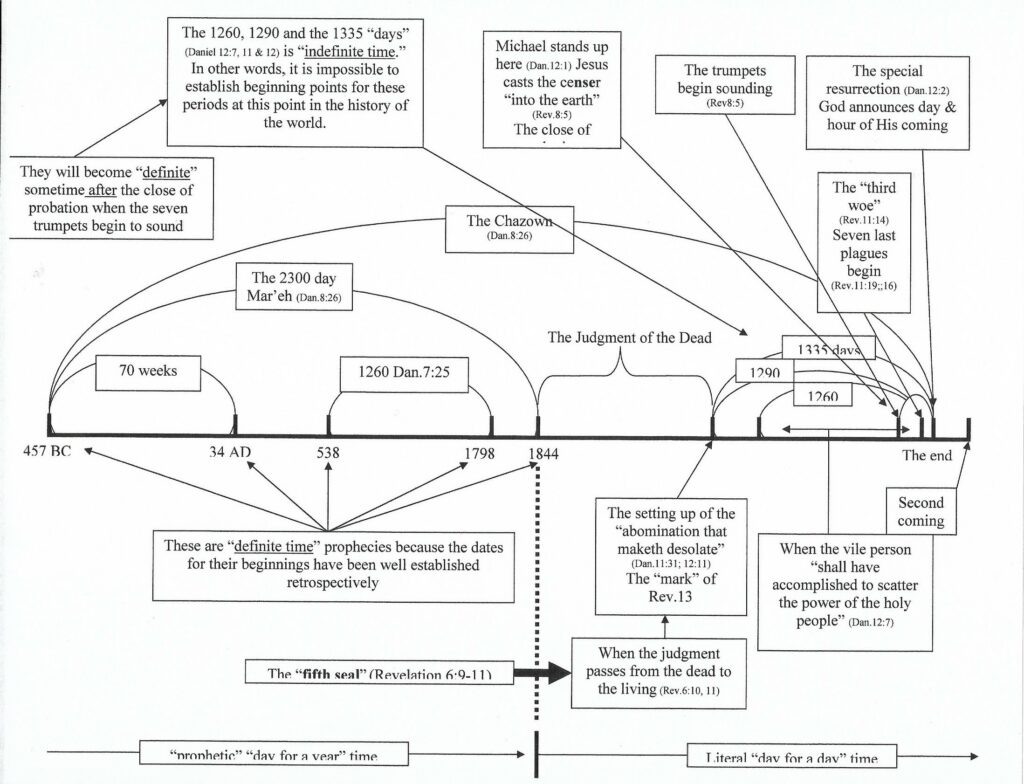
Summary of Chapter 11: This chapter commences with the final thought of Chapter 10, the “present waiting time” during the antitypical day of Atonement beginning after the “book,” John was told to eat, became “bitter.” Chapter 11 immediately moves into a time of adversity and trial symbolized by “the temple of God” being trodden under foot by the Gentiles. That trial is a test, and the response of the worshipers is assessed by the measuring rod representing God’s law. The adversity purifies the church militant, and it then becomes the church triumphant or the “holy city.” Two references to time as “forty and two months” and “two hundred and threescore days” suggests a twofold application of time, namely the 1260 years of the historic Dark Age and a literal 3 1/2-year future Dark Age. Next, we encounter the loud cry scenario of Verses 3 to 6 where the two witnesses, representing the testimony of the Bible, are given tremendous power by the Holy Spirit to warn the world of what is to come. The voice of warning ends when their testimony “is finished” (Verse 7). Then, Verses 8-13 present the victory celebration by the earthly dwellers whose conquest in the battle of the sixth trumpet (last depicted in Revelation 9:14-21) is celebrated for 3 1/2 literal days. The scorn against the two witnesses is unremitting for 3 1/2 days until an earthquake demolishes a portion of the “city” (Verse 8), the place “where our Lord was crucified,” namely, Jerusalem. There, it seems, seven thousand of Wormwood’s disciples were slain bringing terror to the survivors who then realize Wormwood is the same person as Abaddon/Apollyon (the destroyer), whom they previously thought was their opponent. Now, assuming Abaddon/Apollyon to be God, they begin to worship him! Then the “third woe” or the seventh trumpet scenario (Verse 14) begins without delay when God Himself takes control away from the hand of Satan (Abaddon/Apollyon) and begins to pour out the seven last plagues. That must be the meaning, because of the many parallels existing between Verses 18 and 19 and Chapters 15 and 16.
———————————————————————————————————————————-
[1] Testimonies for the Church by E.G. White, Vol. 1, page 409
[2] Seventh-day Adventist Bible Commentary, Vol. 7, page 800
[3] Last Day Events by E.G. White, page 44
[4] The Great Controversy by E.G. White, page 422 (italics supplied)
[5] Spirit of Prophecy by E.G. White, Vol. 4, page 266 (italics supplied)
[6] see Seventh-day Adventist Bible Commentary, Vol. 7, page 796 (right column under “1. I saw.”)
[7] The sixth trumpet scenario begins in Revelation 9:12, 13 when “one woe is past; and behold, there come two woes more hereafter. And the sixth angel sounded . . .” his trumpet. Although that trumpet continues to the end of chapter 9, we will find that scenario taken up again in Revelation 11:8.
[8] see Great Controversy pages 265-288 chapter 15 entitled “The Bible and the French Revolution.” Rev. 11:2-11 is referred to on page 266; Rev. 11:4, page 267; Rev. 11:5, page 268; Rev.11:11, 12, page 287.
[9] http://en.wikipedia.org/wiki/French_Revolution
[10] Manuscript Releases by E.G. White, Vol. 21, pages 90, 91 (italics & ellipse supplied); Last Day Events by E.G. White, page 95
[11] Youth’s Instructor 8-25-86
[12] According to the Commentary, the authors place the writings of the Revelation during the time of Domitian’s reign, or about A.D. 96. (Seventh-day Adventist Bible Commentary, Vol. 7, page 721 (third paragraph)
[13] Ibid, page 801 (top left column)
[14] Ibid (under “Them that worship.”)
[15] “The work is going on in the heavenly court. In vision on the Isle of Patmos John said: ‘And there was given me a reed like unto a rod, and the angel stood, saying, Arise and measure the temple of God, and the altar, and them that worship therein.’ This solemn work is to be done upon the earth.” (The Youth’s Instructor 8-25-86) Although White does not designate a “church” in that quote, it seems clear the “temple” to be “measured” must be the judgment of Laodicea, since it is the last church to be “measured.” Bear in mind also “that the churches to which John was told to send the instruction given him represent all the churches in our world.” (Manuscript Releases Vol.,1, page 372, italics supplied) The Commentary notes: “The Laodicean . . . has been defined as meaning ‘judging the people,’ or ‘a people adjudged.’” (Seventh-day Adventist Bible Commentary, Vol. 7, page 760, top left column)
[16] see The Great Controversy by E.G. White, pages 342
[17] Upward Look by E.G. White, page 152
[18] Review and Herald 1-16-94
[19] Seventh-day Adventist Bible Commentary, Vol. 7, page 801 (under ”2. The court.”)
[20] The Great Controversy by E.G. White, page 187. Note also this statement: “Satan’s agencies in human form are on the ground. Men have confederated to oppose the Lord of hosts. These confederacies will continue until Christ shall leave His place of intercession before the mercy seat and shall put on the garments of vengeance. Satanic agencies are in every city, busily organizing into parties those opposed to the law of God. Professed saints and avowed unbelievers take their stand with these parties.” (Testimonies for the Church by E.G. White, Vol. 8, page 42, italics supplied)
[21] The Great Controversy by E.G. White, page 266. See also page 49 with this quote: “But as persecution ceased, and Christianity entered the courts and palaces of kings, she laid aside the humble simplicity of Christ and his apostles for the pomp and pride of pagan priests and rulers; and in the place of the requirements of God, she substituted human theories and traditions. The nominal conversion of Constantine, in the early part of the fourth century, caused great rejoicing; and the world, cloaked with a form of righteousness, walked into the church. Now the work of corruption rapidly progressed. Paganism, while appearing to be vanquished, became the conqueror. Her spirit controlled the church. Her doctrines, ceremonies, and superstitions were incorporated into the faith and worship of the professed followers of Christ.”
[22] Ibid, page 480
[23] Act of the Apostles by E.G. White, page 576, 577 (italics supplied)
[24] Seventh-day Adventist Bible Commentary, Vol. 7, page 801 (right column under “My two witnesses.”)
[25] The Great Controversy by E.G. White, page 267
[26] 42 x 30 = 1260
[27] The Great Controversy by E.G. White, page 266
[28] see, for example, Testimonies for the Church by E.G. White, Vol. 1, page 409: “I saw that God tested His people upon time in 1844, but that no time which has since been set has borne the special marks of His hand. He has not tested His people upon any particular time since 1844. We have been, and still are, in the patient waiting time.”
[29] Manuscript Releases by E.G. White, Vol. 21, pages 90, 91, Letter 158, 1906; Also Last Day Events by E.G. White, page 95 (italics supplied)
[30] Seventh-day Adventist Bible Commentary, Vol. 7, page 971 (right column 3rd paragraph)
[31] 1260 divided by 360 = 3.5
[32] Manuscript Releases by E.G. White, Vol. 8, page 413, Vol. 9, page 8
[33] See Seventh-day Adventist Bible Commentary, Vol. 7, page 802. Also noted: “Thus the Scriptures might be described as being in mourning at a time when human traditions are in the ascendancy.” That could be applied equally to history, present, or the future.
[34] adapted from Sermons and Talks by E.G. White, Vol. 1, pages 72, 73. talking about the 144,000 who “were . . . so specially singled out?” (brackets supplied)
[35] White makes a startling comment about this scenario in Word to the Little Flock page 12: “You think, that those who worship before the saints’ feet, (Rev.3:9), will at last be saved. Here I must differ with you; for God shew me that this class were professed Adventists, who had fallen away, and ‘crucified to themselves the Son of God afresh, and put him to an open shame.’ And in the ‘hour of temptation,’ which is yet to come, to show out every one’s true character, they will know that they are forever lost; and overwhelmed with anguish of spirit, they will bow at the saint’s feet.”
[36] see Manuscript Releases by E.G. White, Vol. 21, page 326 (left column, second and third paragraph, parenthesis is in original quote)
[37] The Great Controversy by E.G. White, page 268
[38] “days” in Verses 3 and 6 are both from “hemera,” each a 24-hour day (Strong’s #2250)
[39] Manuscript Releases by E.G. White, Vol. 21, pages 90, 91 (italics suppled); Last Day Events by E.G. White, page 95
[40] see The Great Controversy by E.G. White, page 611, 612 (bracket supplied)
[41] Ibid, page 269
[42] see notes [29] & [39]
[43] “ascendeth” is from: “anabaino” (Strong’s #305) “to go up, rise, mount, be borne up, spring up”
[44] The Great Controversy by E.G. White, page 342
[45] a “city” is depicted some 27 times in the book of Revelation. Depending on the context, they can either be literal or figurative, holy or corrupt.
[46] See The Great Controversy by E.G. White, page 271
[47] Generally speaking, Seventh-day Adventists hold the view that this is France, (see Seventh-day Adventist Bible Commentary, Vol. 7, page 803) but few Adventists are familiar with the admonition to “. . . read the eleventh chapter of Revelation, Read every verse, and learn the things that are yet to take place in the cities.” (see notes [29] & [39]) In that case, it is impossible to consider one country, such as France, to be the sole candidate for that specification.
[48] Ibid; see also note [41],
[49] The Commentary also makes this an alternative suggestion saying: “The fact that this city is said to be the one ‘where also our Lord was crucified’ would seem to identify it as Jerusalem . . .” although they parallel it with the “holy city” of Verse 2. (Seventh-day Adventist Bible Commentary, Vol. 7, page 803 (left column under “The great city.”)
[50] The Great Controversy by E.G. White, page 287
[51] Interestingly, the Commentary acknowledges “difficulty in fixing upon certain precise dates in the history of the hectic period of the French Revolution.” (Seventh-day Adventist Bible Commentary, Vol. 7, page 803 middle of 1st paragraph right column)
[52] see notes [29] & [39]
[53] Note that White appears to support the application of prophetic time to the “three days and an half” saying that after “1793 . . . the decree which prohibited the Bible passed the French Assembly. Three years and a half later a resolution rescinding the decree” was passed. (see The Great Controversy by E.G. White, pages 287, 288 Italics supplied) This might be confusing to some. But this application is consistent with her former statement that after the year 1844, “there can be no definite tracing of the prophetic time.” Also bear in mind her statement where we are admonished to “read the eleventh chapter of Revelation, read every verse, and learn the things that are yet to take place in the cities.” Therefore, after 1844, only literal day-for-a-day time applies.
[54] Manuscript Releases by E.G. White, Vol. 21, page 326 (bracket supplied)
[55] Ibid (parenthesis not supplied)
[56] The Great Controversy by E.G. White, page 287 (bracket supplied)
[Notes 57-63 Deleted]
[64] the word “saw” is from “theoreo” (Strong’s #2334) meaning, not only “to look at” but “mentally consider” or discern, perhaps, in this case to view anew that which they previously rejected or scorned.
[65] The Great Controversy pages 287, 288
[66] Seventh-day Adventist Bible Commentary, Vol. 7, page 804 (top right column under “Tenth part.”)
[67] Ibid, page 789 (right column under “Wormwood.”)
[68] The Commentary suggests that “Chapters 10:1 to 11:14 constitute [the] parenthesis between the sixth and seventh trumpets.” (Seventh-day Adventist Bible Commentary, Vol. 7, page 796) But it is clear that the “parenthesis” ends in Verse 7, when the “testimony” of the two witnesses “is finished.”
[69] Note the similarity of phrasing in Verse 14 “the second woe is past” with Revelation 9:12 where “One woe is past” referring to the previous Verses 1 to 11. Likewise, in Revelation 11:14 where “The second woe is past” must be a reference to the previous Verses 7 to 13.
[70] Seventh-day Adventist Bible Commentary, Vol. 7, page 982, Letter 112, 1890 (bottom of right column); Maranatha by E.G White, page 257
[71] Manuscript Releases by E.G. White, Vol. 21 pages 90, 91; Last Day Events page 95
[72] “quickly” from: “tachu” (Strong’s #5035) “quickly, speedily (without delay)”
[73] According to the Commentary, “Seventh-day Adventists date its beginning as 1844” which introduces a four-year hiatus between 1840 and 1844. (see Seventh-day Adventist Bible Commentary, Vol. 7, page 804 under :“15. The seventh angel.)
[74] Ibid
[75] There are many statements by White depicting just such a post probationary scenario. For example, see The Great Controversy by E.G. White, page 614; Maranatha by E.G. White, page 265; Faith I Live by E.G. White, page 215; Spirit of Prophecy by E.G. White, Vol. 4, page 432.
[76] see Revelation 11:10. In the book of Revelation, those that “dwell” on the earth represent those who have no faith in the truth of God’s word. Their dwelling will be permanent, in contrast to those who “dwell” in heaven, spiritually, not literally.
[77] This represents the implementation of Satan’s ultimate ambition, to be worshipped as God. He was unsuccessful with Jesus in the wilderness of temptation (see Matthew 4:10), but nearly successful with men, especially during this last day scenario.
[78] see, for example, My Life Today by E.G. White, page 308
[79] Seventh-day Adventist Bible Commentary, Vol. 7, page 805 (left column under “Hast taken . . . hast reigned.”)
[80] Review and Herald 8-1-49; Maranatha by E.G. White, page 258; Early Writings by E.G. White, page 36 (seen in vision January 5, 1849)
[81] Ibid. Although White makes no mention of the trumpets in this account (her 1849 vision) she does, at a later date (1890 letter [70]), include the trumpets as events to take place in the future, as well as her counsel in 1906 that Revelation 11 is about future events [29]. It is apparent that White was given additional information as time progressed, as suggested in the comment at the end of the above quote: “He [her attending angel] told me that I could see no more then, but he would shortly show me what those things that I then saw meant.”
[82] Seventh-day Adventist Bible Commentary, Vol. 7, page 805 (left column under “Wrath.”)
[83] Ibid page 804 (right column under “14. The second woe.”)
[84] 2023 – 1840 = 183 years
[85] The word “quickly” is translated from “tachu” (Strong’s #5035)also meaning “speedily (without delay)” even “suddenly.”
[86] Manuscript Releases by E.G. White, Vol. 20, page 221 (underlining supplied for emphasis)
[87] The Great Controversy by E.G. White, page 433
[88] Battle Creek Letters by E.G. White, page 57
[89] Manuscript Releases by E.G. White, Vol. 20, page 221 (italics supplied)
[90] The Commentary has another struggle here. Note (regarding the first half of Verse 19): “It is in connection with the beginning of the seventh trumpet that John sees the temple in heaven . . . This indicates that the second and last division of Christ’s heavenly ministry . . . has opened . . . this final phase of Christ’s work began in 1844 . . . Accordingly, Seventh-day Adventists place the beginning of the seventh trumpet in that year.” Next consider the comments regarding the last half of Verse 19 with the “lightnings, and voices, and thunderings, and an earthquake, and great hail” being all “under the seventh plague.” (Seventh-day Adventist Bible Commentary, Vol. 7, pages 805, 806) That interpretation makes the first half of Verse 19 historic and the last half future.
[91] The Great Controversy by E.G. White, page 639
[92] see note [80]
